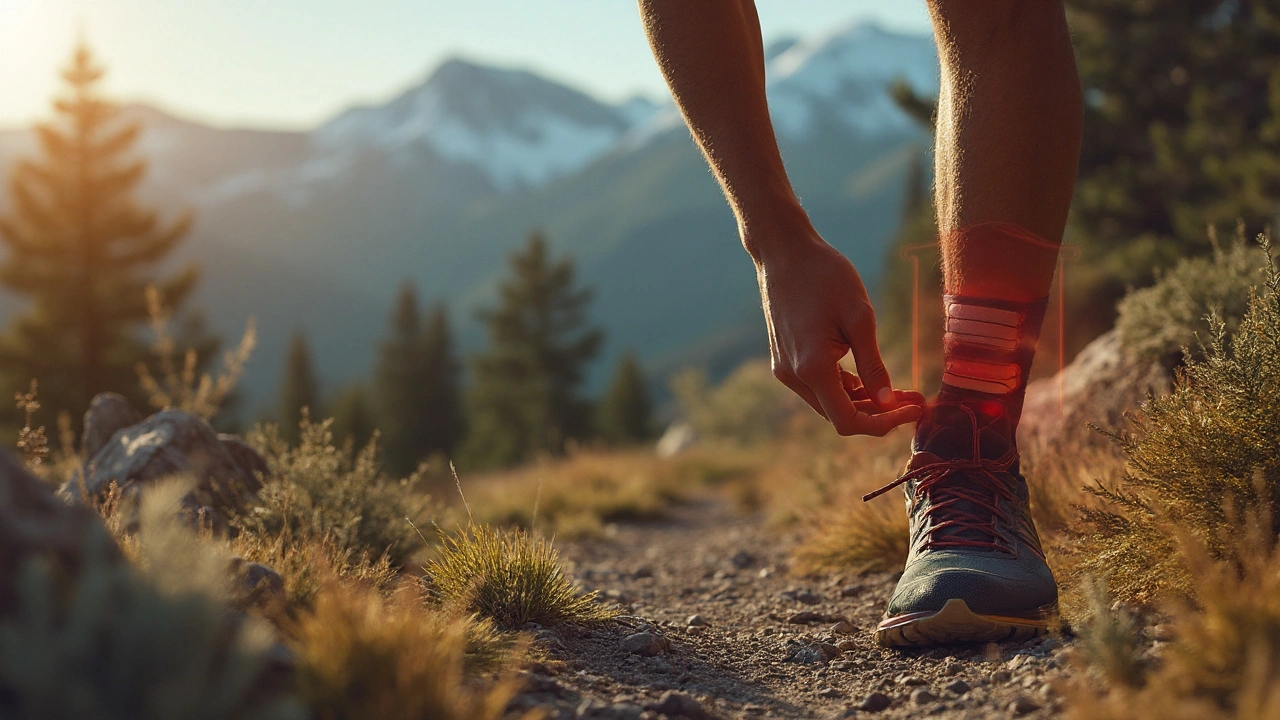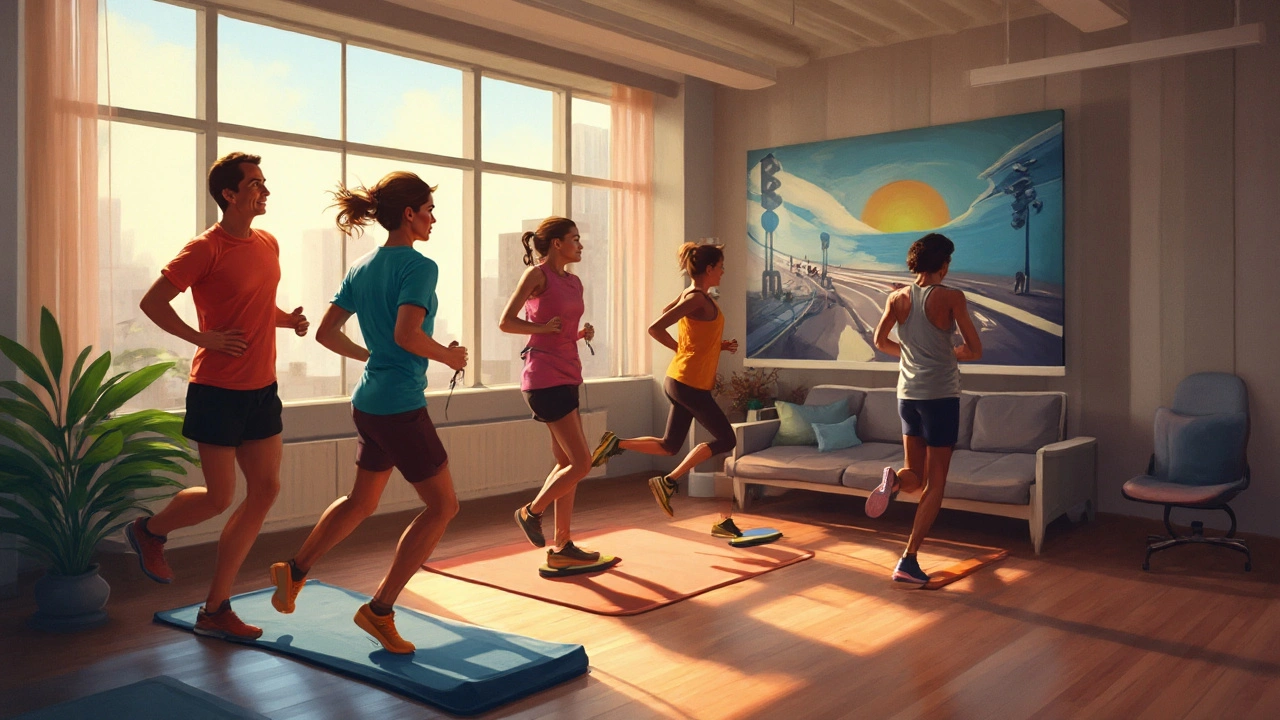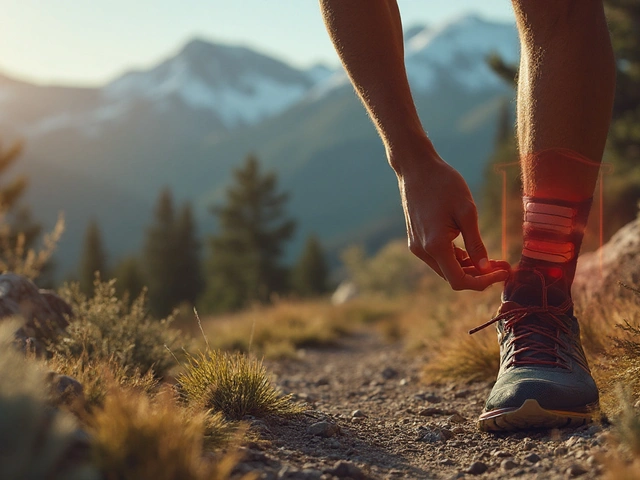Ankle Sprain 101: Essential Guide for Runners

Ankle Sprain Grade Checker & Recovery Planner
Ankle Sprain is a ligament injury around the ankle joint, frequently seen in runners.
Quick Takeaways
- Three sprain grades dictate severity and recovery time.
- Immediate RICE care cuts swelling and speeds healing.
- Physiotherapy and targeted exercises restore stability in 2‑6 weeks for most Grade I‑II cases.
- Strengthening foot biomechanics and using proper orthotics prevent re‑injury.
- Return to running follows a graduated plan: walk‑run, interval, full mileage.
What Exactly Is an Ankle Sprain?
When a runner twists, rolls, or lands awkwardly, the thin bands of tissue called ligaments can stretch or tear. The most common culprits are the anterior talofibular ligament (ATFL) and the calcaneofibular ligament (CFL). A sprain ranges from a microscopic stretch (GradeI) to a complete rupture (GradeIII). Recognizing the grade early helps you choose the right treatment and avoid chronic instability.
Sprain Grades - How They Differ
| Grade | Ligament Damage | Typical Recovery Time | Recommended Care |
|---|---|---|---|
| I | Microscopic stretch, no visible tear | 3‑7days | RICE + gentle range‑of‑motion exercises |
| II | Partial tear, moderate swelling | 2‑4weeks | RICE, bracing, supervised physiotherapy |
| III | Complete rupture, severe instability | 6‑12weeks (or longer if surgery) | Immobilization, possible surgical repair, intensive rehab |
Why Runners Are Prone to Sprains
Running puts repetitive stress on the ankle’s supporting structures. Two factors raise the risk:
- Foot biomechanics: Overpronation or supination forces the ankle into awkward angles during each stride.
- Surface variability: Trail runs, uneven pavement, or sudden changes in elevation increase twist‑injury chances.
Understanding your gait and choosing appropriate shoes can reduce the odds of a sprain before it happens.
Spotting the Symptoms Early
Typical signs include:
- Sharp pain at the outer ankle immediately after the incident.
- Swelling that peaks within 24hours.
- Bruising or discoloration.
- Difficulty bearing weight or a feeling of “giving way.”
If pain persists beyond a few days, or if you notice instability, seek professional evaluation.
Immediate Care: The RICE Protocol
RICE is a standard first‑aid method standing for Rest, Ice, Compression, Elevation. Applying RICE within the first 48hours limits inflammation and protects the ligament from further strain.
- Rest: Stop running; use crutches if bearing weight is painful.
- Ice: 15‑20minutes every 2hours; avoid direct skin contact.
- Compression: Elastic wrap at a snug but comfortable pressure.
- Elevation: Keep the ankle above heart level to promote fluid drainage.

When to Get Professional Imaging
Most GradeI injuries heal with RICE alone. For GradeII‑III or when instability persists, imaging helps confirm ligament status. The two most common modalities are:
- X‑ray provides bone‑level detail to rule out fractures.
- MRI offers high‑resolution soft‑tissue view, ideal for grading ligament tears.
Doctors typically order an MRI if swelling remains high after 5‑7days or if the ankle feels unstable during weight‑bearing tests.
Treatment Paths: From Bracing to Physiotherapy
After diagnosis, treatment follows the sprain grade:
- GradeI: RICE plus a simple elastic sleeve; gentle ankle circles after 2‑3days.
- GradeII: Semi‑rigid brace for 1‑2weeks, followed by supervised physiotherapy focusing on proprioception.
- GradeIII: Immobilization in a cast or walking boot; surgical consultation if instability persists. Post‑op rehab can last 3‑4months.
Physiotherapy is a targeted rehab program that restores strength, balance, and range of motion. A typical session includes:
- Thermal modalities (heat or cold) to prepare tissue.
- Manual mobilization of the talus and subtalar joint.
- Progressive strengthening: resistance bands, calf raises, single‑leg balance.
- Proprioceptive drills: wobble board, single‑leg hops.
Rehabilitation Exercises for Runners
Below is a 4‑week progression that most runners can follow after the acute swelling subsides:
- Week1: Ankle alphabet (draw letters with big toe), towel scrunches, seated calf raises.
- Week2: Standing heel‑to‑toe walks, single‑leg balance on soft surface (30seconds).
- Week3: Resistance band eversion/inversion (3sets×15 reps), controlled lunges.
- Week4: Light plyometrics-jump rope, lateral hops, gradual return to short jogs (5‑10min).
Consistency is key; missing a session can delay the timeline by several days.
Preventing Future Sprains
Prevention blends three pillars:
- Strength & Flexibility: Regular calf‑gastrocnemius and tibialis posterior work keeps ligaments supple.
- Footwear & Orthotics: Choose shoes with adequate arch support and lateral stability. Orthotics provide customized foot alignment that reduces abnormal ankle torque.
- Running Form: Maintain a mid‑foot strike, avoid overstriding, and keep hips level to minimize ankle torsion.
Incorporating a weekly “strength day” and a monthly gait analysis can slash re‑injury risk by up to 40% according to a 2023 sports medicine study.
Returning to Running - A Safe Timeline
Every athlete’s path varies, but a general framework looks like this:
- Days1‑3: Rest, RICE, light ankle mobility.
- Days4‑7: Begin low‑impact cardio (swimming, cycling) while maintaining ankle exercises.
- Weeks2‑3: Introduce walk‑run intervals (e.g., 1min run / 2min walk) on even terrain.
- Weeks4‑6: Gradually increase running time, add hill work only if ankle feels stable.
- Beyond6weeks: Full mileage return if no pain, incorporate regular strength work to maintain stability.
If pain resurfaces at any stage, scale back and focus on rehab before advancing.
Related Concepts and Next Steps
Understanding ankle sprains opens doors to broader topics that every runner should explore:
- Foot Biomechanics: How pronation patterns influence ankle stress.
- Cross‑Training: Low‑impact activities that keep cardiovascular fitness while protecting the ankle.
- Nutrition for Healing: Protein and omega‑3 intake that supports ligament repair.
- Sports‑Specific Taping: When and how to tape an ankle for race day.
Delving into these areas will round out your injury‑prevention toolbox and make you a smarter, stronger runner.
Frequently Asked Questions
How do I know if my ankle sprain is GradeI or GradeII?
GradeI feels like a mild stretch with little swelling and no loss of stability. GradeII presents moderate swelling, bruising, and a noticeable “giving way” when you try to bear weight. An X‑ray rules out bone injury, while an MRI confirms the extent of ligament tearing.
Can I run with a brace after a GradeII sprain?
Yes, but only after the initial swelling subsides (usually 3‑5days) and you’ve completed a few physiotherapy sessions. Choose a semi‑rigid brace that limits excessive inversion while still allowing a natural gait.
Is surgery ever necessary for an ankle sprain?
Surgery is rare and typically reserved for GradeIII injuries that remain unstable after 6weeks of conservative treatment or for athletes who need a guaranteed return to high‑level performance. The procedure repairs the torn ligament and is followed by an intensive rehab program.
How long should I wait before doing strength training after a sprain?
Gentle isometric exercises can start within 48hours if pain is manageable. Progressive resistance work (bands, calf raises) usually begins in week2 for GradeI and week3 for GradeII, always under physiotherapist guidance.
Do orthotics really prevent ankle sprains?
Custom orthotics that correct overpronation or excessive supination can reduce unwanted ankle rotation by up to 30%, according to a 2022 clinical trial. They’re most effective when paired with strength training and proper shoe choice.
What’s the best way to ice my ankle without freezing the skin?
Wrap a thin towel around a frozen gel pack and apply it for 15‑20minutes. Remove it for at least 40minutes before the next session to avoid skin damage.



Sharley Agarwal
Why do people even bother running? Ankle sprains are just nature’s way of saying ‘sit down.’
prasad gaude
Running is not just sport-it’s a meditation on the fragility of the human body. Each step is a whisper to gravity, and sometimes, gravity whispers back with a twist. The ankle? A temple of balance. When it breaks, we don’t just heal-we remember.
Timothy Sadleir
Let me be clear: this RICE protocol is a government-backed placebo designed to keep you compliant. The real solution? Cold laser therapy, which Big Pharma suppresses because it’s too cheap. And orthotics? They’re just shoe inserts made by corporations that profit from your fear of movement. You’re being manipulated into believing you need ‘support’-when your body was designed to move without gadgets.
Srikanth BH
You got this. Ankle sprains suck, but they’re temporary. Stick to the rehab plan-even if it’s just 5 minutes a day. Progress isn’t loud, it’s quiet. One calf raise at a time. One balance hold. One step closer to running again. You’re stronger than you think.
Jennifer Griffith
who even wrote this? i think they meant 'rince' not 'rice' lol and why are there so many words for something that's just a twisted ankle??
Roscoe Howard
It’s no surprise that Americans are so injury-prone. We’ve turned running into a cult of self-flagellation. In my country, we walk. We hike. We respect our joints. This entire article reads like a corporate fitness manual written by someone who’s never held a real job. And ‘proprioceptive drills’? That’s just fancy talk for ‘stand on one foot while panicking.’
Kimberley Chronicle
From a biomechanical standpoint, the anterior talofibular ligament (ATFL) is indeed the most frequently injured structure in inversion sprains, accounting for approximately 85% of cases. However, recent literature (2023, JOSPT) suggests that neuromuscular control deficits-particularly in the peroneal complex-are more predictive of recurrence than ligament integrity alone. A multimodal approach integrating dynamic stability training, eccentric loading, and sensorimotor re-education yields superior long-term outcomes compared to RICE alone. I’d argue that the RICE protocol, while historically sound, is now outdated without concurrent neuromotor retraining.
Shirou Spade
There’s a quiet truth in every sprain: the body doesn’t break because it’s weak. It breaks because it’s been ignored. We run on autopilot, chasing miles, not awareness. The ankle doesn’t scream until it’s been whispered to for years. Maybe healing isn’t about exercises. Maybe it’s about listening.
Lisa Odence
Okay, but let’s be real-this guide is *almost* perfect, but it completely skips over the role of vitamin C and collagen peptides in ligament repair. 🤔 Did you know that 10g of hydrolyzed collagen daily + 500mg of vitamin C can increase collagen synthesis by up to 48%? 🧬✨ Also, ice? Overrated. Cold water immersion is better, but only if you do it at 10–15°C for 11 minutes max-otherwise you risk vasoconstriction-induced fibrosis. 🥶 And don’t even get me started on how most ‘orthotics’ are just plastic death traps. Custom-molded, carbon-fiber, midfoot-stabilizing orthotics are the *only* way. 🏃♀️🩹 #AnkleRecovery #ScienceBacked #CollagenIsLife